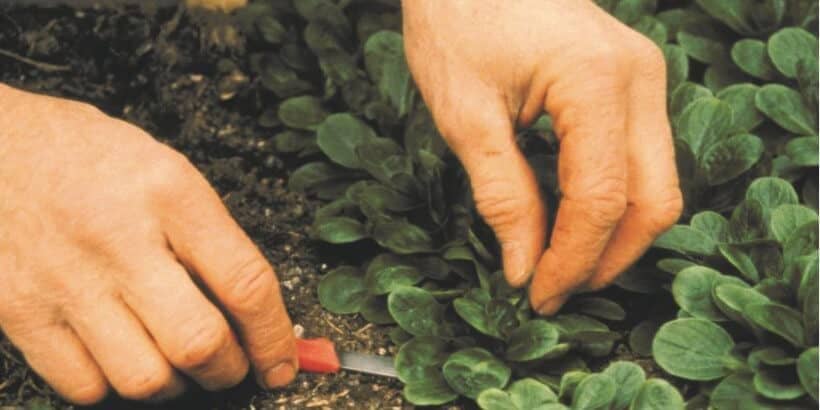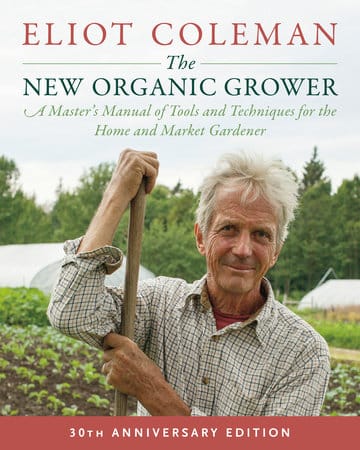How to Use Climate Maps to Navigate the Winter Harvest

Continuing to grow your crops and harvest them well into the winter months seems like an impossible task. How can they grow when weather conditions are far from warm sunny days? It’s all about adapting to what the season gives you. With the proper techniques and studying the patterns of your area’s climate, growing and harvesting your food in the cold months is easier than you think.
The following is an excerpt from The Winter Harvest Handbook by Eliot Coleman. It has been adapted for the web.
In the winter, some of the challenges in harvesting crops are different than during the summer. For example, we are often more concerned with keeping our fingers warm than we are about cooling the freshly cut produce. But efficient techniques and good tools remain just as important in winter as in summer.
Our harvest days are Mondays and Thursdays. We deliver our winter crops either late those afternoons or early the following mornings to stores and restaurants in our local area. When harvesting in winter from unheated greenhouses in cold-climate areas, it is often necessary to follow a flexible schedule on harvest days.
After a below-zero night we often start late in the unheated houses because we have to wait until the interior air temperature warms above 32F. Even on the coldest days we can usually count on a harvest window from 10:00AM until 3:00PM. Before 10:00 everything is still thawing and after 3:00 it starts to freeze up again. During mid-winter having at least one cool greenhouse will pay for itself in efficiency. You can begin harvesting salad crops there in the early morning, then harvest in the cold houses, and return to the cool house to harvest radishes and turnips in late afternoon.
Staying Warm While Working
In order to be able to guarantee timely delivery to stores and restaurants some supplementary heat may be necessary on occasion. We have a propane-fired salamander heater in reserve for the occasional day when it is so cold and snowy and cloudy that there is not enough sun to warm the unheated houses above freezing. Those days are rare: we have fired up this heater on average only one harvest day each winter. We have never run the heater just to warm ourselves up, but occasionally we have been tempted. On bright sunny days, of course, the harvest window is wider and the temperature inside the houses is down right pleasant.
We dress warmly for harvesting in the cold houses. (I favor a vest instead of a parka.) We cut with small, sharp Victorinox knives (7 inches overall, 3-inch blade) and sharpen them frequently. We place the cut leaves in food-grade five-gallon buckets. If the sun does not warm the houses into the 50F range, we endure the pain of frosty fingers. We have neoprene gloves available (the ones cold-weather kayakers wear), but I find even the thinnest are awkward to wear while picking. I usually wear one on my knife hand and leave the other hand bare. I soak the bare hand in warm water every time I return to the packing area with full buckets.
We’ve learned from experience to replace the inner covers as soon as we finish harvesting. Once the greenhouse temperatures drop below freezing, the light row-cover material quickly freezes to itself and is impossible to place back over the supporting wickets without tearing. The PVA covers mentioned in chapter 6 are stronger and less of a problem in that regard but, nevertheless, it is still the best practice to recover each section as soon as possible.
Climate Maps
These maps are included to help convince growers all across the country to give the winter harvest a try. There are not many places with longer winters than we have here in Maine, but during the 1980s, when I first began seriously experimenting with these ideas, I was living on a farm in the mountains of Vermont in Zone 3. The winter harvest worked just fine there also.
The four climate maps that follow enable comparisons to be made between many factors of the winter climate in different regions of the country:
The above map shows average January temperatures across the country. It demonstrates that much of the U.S. has the same or warmer January temperatures as does the south of France where winter vegetable production in high tunnels is common practice.
This second map is the standard USDA zone map. It divides up the country according to minimum temperatures reached during the winter. Our farm in Maine is rated as Zone 5. The zone map is of some use in comparing different parts of the country vis-à-vis how cold it gets, but it does not take into consideration how long the winter goes on.
The third map, titled Mean Annual Number of Days Minimum Temperature 32F and Below, gives a good idea of the length of the winter period. Our farm is located two-thirds of the way up the Maine coast on the 150-day line. A farm in northeastern Missouri with a similar Zone 5 rating from map 2 would be on the 90-day line, quite a difference in length of winter.
This fourth map, Average Depth of Frost Penetration, offers another way to look at the severity of the winter. At our location on the coast of Maine the average frost depth is 48 inches. That imaginary farm in northeastern Missouri mentioned above experiences an average frost depth of only 20 inches, quite a difference in severity of winter.
Recommended Reads
Recent Articles
Aside from the sheer pleasure of telling your friends, straight-faced, that you maintain your garden using something called a “chicken tractor,” there are a slew of other benefits to working the land with a few of your animal friends. Getting rid of pests without chemicals, for one; letting them do the work of weeding and…
Read MoreIf the idea of running a vegetable farm sounds daunting, you’re not alone. What can you do to simplify techniques and reduce expenses? Where do you even begin?
Read MoreWhen you’re walking around the grocery store looking at the vegetables, it’s probably hard to imagine that a century ago there was twice the amount of options.
Read MoreIf you love tomatoes, you probably already know just how many varieties of these summertime staples there are. But do you know what makes each one unique?
Read MoreAdding the long game of trees to your system results in a deeper and more reliable, resilient and profound presence to your annual vegetable production.
Read More












